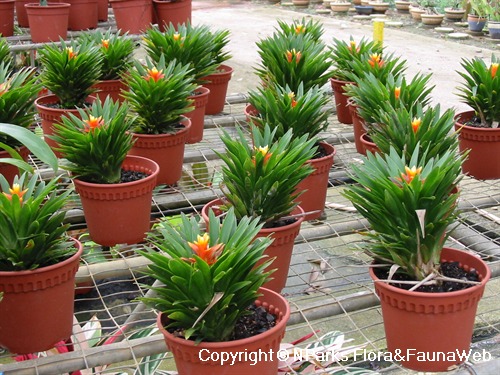
Name
Classifications and Characteristics
| Plant Growth Form | Herbaceous Plant |
|---|---|
| Lifespan (in Singapore) | Annual |
Biogeography
| Native Distribution | West Indies & Central America to Brazil |
|---|---|
| Native Habitat | Terrestrial |
| Local Conservation Status | Non-native (Horticultural / Cultivated Only) |
Description and Ethnobotany
| Growth Form | An epiphytic herb, it grows as a rosette and has a clumping growth habit. |
|---|---|
| Foliage | The simple leaves, arranged in a rosette are dark green and glossy, the leaves are soft and flexible to the touch. |
| Flowers | The flowers are borne on a terminal inflorescence. The flowers are creamy yellow while the bracts are red and are long-lasting. |
| Habitat | It can be found growing from sea level to 1000m altitude. |
| Cultivation | It is best grown under partial shade and is best grown in well-draining and moist growing media. The cups between the leaf sheaths should be filled with water. It prefers slightly acidic conditions. |
Landscaping Features
| Desirable Plant Features | Ornamental Flowers, Ornamental Form |
|---|---|
| Landscape Uses | Interiorscape/ Indoor Plant, Parks & Gardens, Small Gardens, Flowerbed / Border, Container Planting |
Plant Care and Propagation
| Light Preference | Semi-Shade |
|---|---|
| Water Preference | Occasional Misting, Little Water |
| Rootzone Tolerance | Moist Soils, Well-Drained Soils, Acidic (low pH) Soils |
| Propagation Method | Division |
Foliar
| Mature Foliage Colour(s) | Green |
|---|---|
| Leaf Area Index (LAI) for Green Plot Ratio | 3.5 (Shrub & Groundcover - Monocot) |
Floral (Angiosperm)
| Flower Colour(s) | Red, Yellow / Golden |
|---|---|
| Flower Grouping | Cluster / Inflorescence |
| Flower Location | Terminal |
Image Repository
Others
| Master ID | 755 |
|---|---|
| Species ID | 2050 |
| Flora Disclaimer | The information in this website has been compiled from reliable sources, such as reference works on medicinal plants. It is not a substitute for medical advice or treatment and NParks does not purport to provide any medical advice. Readers should always consult his/her physician before using or consuming a plant for medicinal purposes. |





